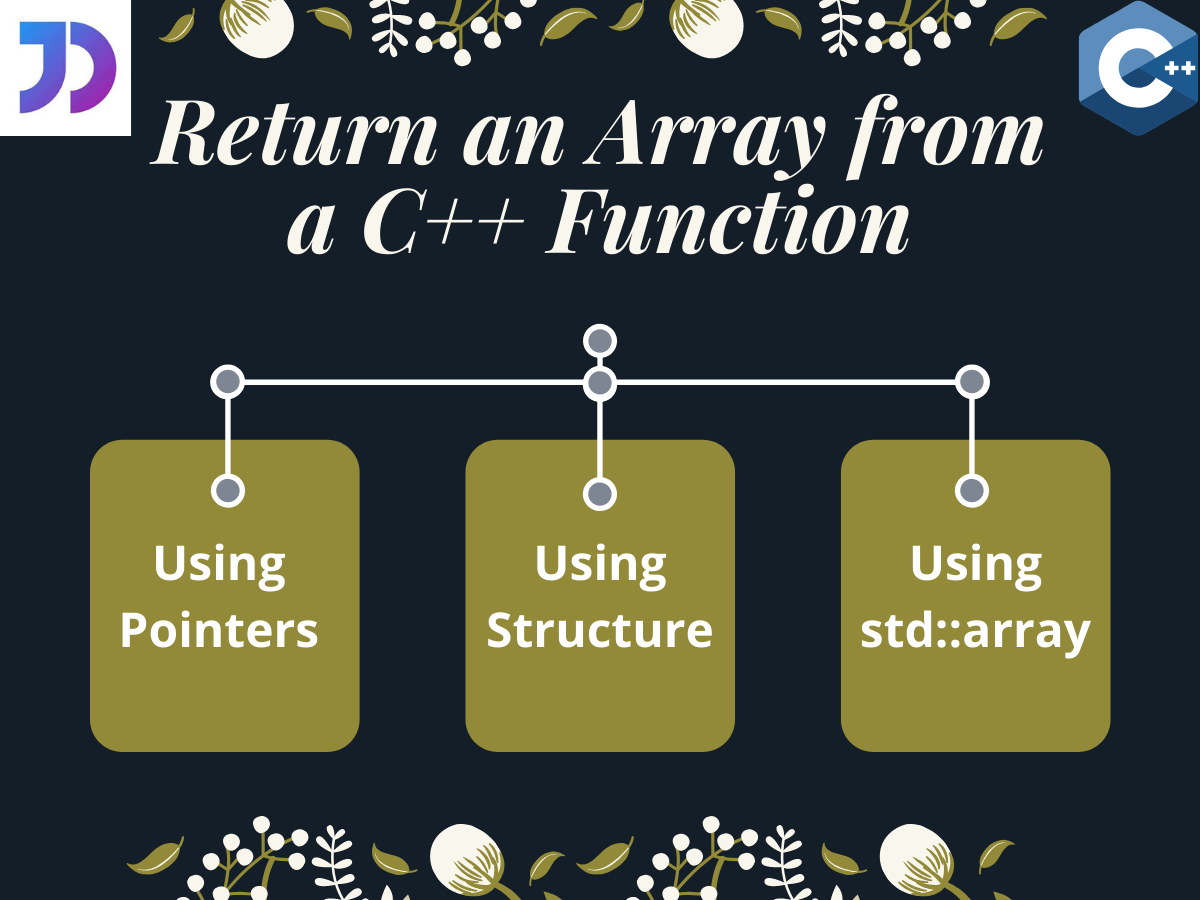- Log in to:
- Community
- DigitalOcean
- Sign up for:
- Community
- DigitalOcean

Introduction
In this tutorial, we are going to understand how we can return an array from a function in C++.
Methods to Return an Array in a C++ Function
Typically, returning a whole array to a function call is not possible. We could only do it using pointers.
Moreover, declaring a function with a return type of a pointer and returning the address of a C type array in C++ doesn’t work for all cases. The compiler raises a warning for returning a local variable and even shows some abnormal behavior in the output.
Hence, returning an array from a function in C++ is not that easy. But we can accomplish that by following any of the below mentioned methods.
Let’s get right into it.
1. Using Pointers
As we mentioned earlier, returning a normal array from a function using pointers sometimes gives us unexpected results. But this behaviour and warnings can be avoided by declaring the array to be a static one.
Let us see how.
#include<iostream>
using namespace std;
int* demo() //return type- address of integer array
{
static int a[5]; //array declared as static
for(int i = 0; i<5; i++)
{
a[i] = i; //array initialisation
}
return a; //address of a returned
}
int main()
{
int* ptr; //pointer to hold address
int i;
ptr = demo(); //address of a
cout<<"Array is: ";
for(i=0 ; i<5; i++)
cout<<ptr[i]<<"\t"; //ptr[i] is equivalent to *(ptr+i)
return 0;
}
Output:
Array is: 0 1 2 3 4
Here, we have declared the function demo() with a return type int *(pointer) and in its definition, we have returned a (serves as both array name and base address) to site of the function call in main().
As we can see from the above output, the array is successfully returned by the function.
2. Using a Structure in C++
We can also make a function return an array by declaring it inside a structure in C++. Let us see how.
#include <iostream>
using namespace std;
struct demo
{
//array declared inside structure
int arr[100];
};
struct demo func(int n) //return type is struct demo
{
struct demo demo_mem; //demo structure member declared
for(int i=0;i<n;i++)
{
//array initialisation
demo_mem.arr[i] = i;
}
return demo_mem; //address of structure member returned
}
int main()
{
struct demo a;
int n=5; //number of elements
a=func(n); //address of arr
cout<<"The Array is : ";
for(int i=0;i<n;i++)
{
cout<<a.arr[i]<<"\t";
}
return 0;
}
Output:
Array is: 0 1 2 3 4
Here, note that we have declared the array arr inside the structure demo. And this time the function has a return type of the structure itself and return demo_mem (structure variable) instead of the array.
In this way using another structure variable a, we can access the array arr in the main() function.
3. Using std::array
For std::array in C++, returning the array name from a function actually translates into the the whole array being returned to the site of the function call.
#include <iostream>
#include<array>
using namespace std;
std::array<int,5> func() //function with return type std::array
{
std::array<int,5> f_array; //array declared
for(int i=0;i<5;i++)
{
//array initialisation
f_array[i] = i;
}
return f_array; //array returned
}
int main()
{
std::array<int,5> arr; //array with length 5
arr=func(); //function call
cout<<"The Array is : ";
for(int i=0;i<5;i++)
{
cout<<arr[i]<<"\t";
}
return 0;
}
Output:
Array is: 0 1 2 3 4
Hence it is clear from the output, that the array return by the function func() was successful.
Conclusion
So in this tutorial, we learned about the different methods by which we can return an array from a C++ function.
For any further questions, feel free to use the comments below.
References
- C++ return array from function - StackOverflow Question,
- Two Dimensional Array in C++ - Journal Dev Post.
Thanks for learning with the DigitalOcean Community. Check out our offerings for compute, storage, networking, and managed databases.
Still looking for an answer?
Deploy on DigitalOcean
Click below to sign up for DigitalOcean's virtual machines, Databases, and AIML products.
Become a contributor for community
Get paid to write technical tutorials and select a tech-focused charity to receive a matching donation.
DigitalOcean Documentation
Full documentation for every DigitalOcean product.
Resources for startups and SMBs
The Wave has everything you need to know about building a business, from raising funding to marketing your product.
Get our newsletter
Stay up to date by signing up for DigitalOcean’s Infrastructure as a Newsletter.
New accounts only. By submitting your email you agree to our Privacy Policy
The developer cloud
Scale up as you grow — whether you're running one virtual machine or ten thousand.
Get started for free
Sign up and get $200 in credit for your first 60 days with DigitalOcean.*
*This promotional offer applies to new accounts only.
